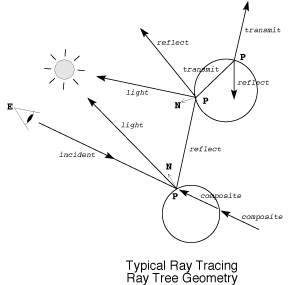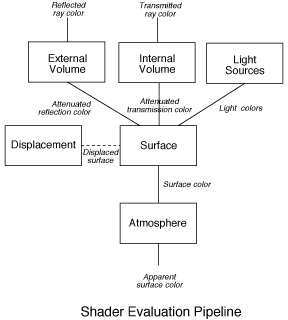 Overview of the Shading Process
Overview of the Shading Process Overview of the Shading Process
Overview of the Shading ProcessIn this document, shading includes the entire process of computing the color of a point on a surface. The shading process requires the specification of light sources, surface material properties, and volume or atmospheric effects. The interpolation of color across a primitive, in the sense of Gouraud or Phong interpolation, is not considered part of the shading process. Each part of the shading process is controlled by giving a function which mathematically describes that part of the shading process. Throughout this document the term shader refers to a procedure that implements one of these processes. There are thus three major types of shaders:
Conceptually, it is easiest to envision the shading process using ray tracing (see Figure 9.1). In the classic recursive ray tracer, rays are cast from the eye through a point on the image plane. Each ray intersects a surface which causes new rays to be spawned and traced recursively. These rays are typically directed towards the light sources and in the directions of maximum reflection and transmittance. Whenever a ray travels through space, its color and intensity is modulated by the volume shader attached to that region of space. If that region is inside a solid object, the volume shader is the one associated with the interior of that solid; otherwise, the exterior shader of the spawning primitive is used. Whenever an incident ray intersects a surface, the surface shader attached to that geometric primitive is invoked to control the spawning of new rays and to determine the color and intensity of the incoming or incident ray from the color and intensity of the outgoing rays and the material properties of the surface. Finally, whenever a ray is cast to a light source, the light source shader associated with that light source is evaluated to determine the color and intensity of the light emitted. The shader evaluation pipeline is illustrated in Figure 9.2.
Figure 9.1 The ray tracing paradigm

(click on image to view a larger version)
Figure 9.2 Shader evaluation pipeline

(click on image to view a larger version)
This description of the shading process in terms of ray tracing is done because ray tracing provides a good metaphor for describing the optics of image formation and the properties of physical materials. However, the Shading Language is designed to work with any rendering algorithm, including scanline and z-buffer renderers, as well as radiosity programs.
The Shading Language is also used to program two other processes:
No part of this publication may be reproduced, stored in a retrieval system, or transmitted, in any form or by any means, electronic, mechanical, photocopying, recording, or otherwise, without the prior written permission of Pixar. The information in this publication is furnished for informational use only, is subject to change without notice and should not be construed as a commitment by Pixar. Pixar assumes no responsibility or liability for any errors or inaccuracies that may appear in this publication.
|
Pixar Animation Studios
|